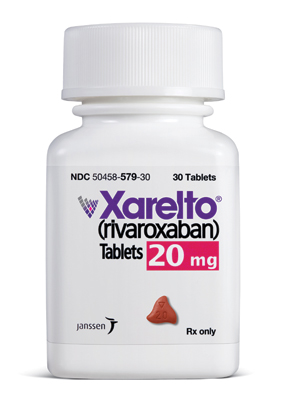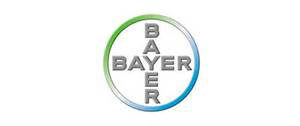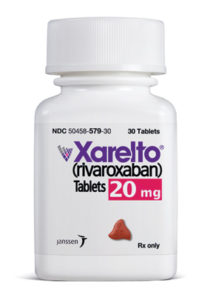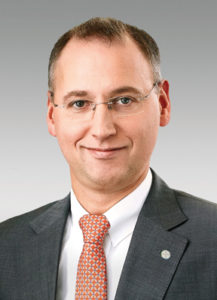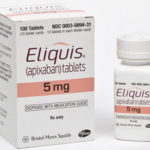Bayer: Focus On Life Science
Bayer revamped its business model by spinning off its MaterialsScience sector into an independent company in 2015 and acquired Monsanto during 2016.
Bayer AG
51368
Leverkusen, Germany
Telephone: +49 214 30-1
Website: bayer.com
Best-Selling Products
| Product | 2015 Sales | 2014 Sales |
|---|---|---|
| Xarelto | $2,499 | $1,863 |
| Eylea | $1,363 | $842 |
| Kogenate | $1,282 | $1,231 |
| Mirena product family |
$1,074 | $909 |
| Nexavar | $990 | $858 |
| Betaseron/Betaferon | $914 | $909 |
| Yaz/Yasmin/ Yasminelle |
$783 | $852 |
| Adalat | $702 | $652 |
| Aspirin Cardio | $581 | $539 |
| Glucobay | $580 | $492 |
All sales are in millions of dollars.
Exchange rate for all figures listed above:
EUR 1.1096 = $1.00
Financial Performance
| 2015 | 2014 | |
|---|---|---|
| Revenue | $51,401 | $45,870 |
| Net income | $4,547 | $3,820 |
| Diluted EPS | $5.51 | $4.59 |
| R&D expense | $4,750 | $3,925 |
| 1H16 | 1H15 | |
|---|---|---|
| Revenue | $26,283 | $26,404 |
| Net income | $3,208 | $2,772 |
| Diluted EPS | $3.88 | $3.35 |
| R&D expense | $2,476 | $2,196 |
In millions of dollars, except EPS
Exchange rate for all figures listed above:
EUR 1.1096 = $1.00
Bayer continues to sharpen its focus as a pure life sciences company. A year ago in October, the company floated its MaterialScience subgroup on the market. Now known as Covestro, it is legally and economically independent from Bayer. And in 2016, the company succeeded in its goal to acquire agricultural giant Monsanto.
According to Dr. Martin Dekkers, the former chairman of Bayer, “Now we are focusing solely on living organisms.” Dekkers was succeeded as chairman by CEO Werner Baumann in May 2016.
The company is operating now with three divisions: Pharmaceuticals, Consumer Health, and CropScience.
“Our portfolio is well diversified and balanced, both in terms of profitability and risks,” Dr. Dekkers says. “Our divisions are highly competitive holding leadership positions in their markets. And our focused business model offers significant potential to leverage synergies across the board – from research to product approval processes and from operations to talent development. It is important to sustain this momentum and continue reaping the fruits of our strategy.”
Since January 2016, the heads of the three new divisions have been members of the Board of Management of Bayer AG. According to Dr. Dekkers, “This enhances operational accountability and accelerates decision-making, which are important for an innovation company.”
Financial & Product Performance
According to executives, Bayer’s transformation into a pure Life Science company has consistently been accompanied by robust financial results. “Over the last five years we showed very good performance,” Dr. Dekkers says. “It demonstrates the strength of our company and the commitment of our employees.”
In 2015, revenue from continuing operations rose to a record level of €46.32 billion ($51.4 billion), 12 percent more than in 2014. Net income was €4.1 billion ($4.55 billion), an increase of 19 percent. Diluted earnings per share were €4.97 ($5.51), 20 percent more than in 2014.
In the first half of 2016, Bayer reported sales of €23.69 billion ($26.28 billion). Net income was €2.89 billion ($3.21 billion).
Sales of the Pharmaceuticals segment – the company’s largest segment in terms of sales – were €13.75 billion ($15.26 billion) in 2015, 14 percent more than in 2014. Bayer’s five recently launched products – Xarelto, Eylea, Stivarga, Xofigo, and Adempas – again contributed to this performance with combined sales of €4.2 billion ($4.66 billion), compared with €2.9 billion ($3.22 billion) in 2014.
First-half 2016 sales of the Pharmaceuticals sector amounted to €7.99 billion ($8.87 billion), 7.3 percent more than in the same period last year.
In 2015, Bayer’s top-selling Pharmaceuticals sector products were the blood thinner Xarelto, the eye drug Eylea, the hemophilia product Kogenate, the Mirena family of birth control devices, the cancer drug Nexavar, the multiple sclerosis drug Betaferon/Betaseron, the birth control drug Yaz/Yasmin/Yasminelle, the heart drugs Adalat and Aspirin Cardio, and the diabetes drug Glucobay.
Xarelto achieved sales of €2.25 billion ($2.5 billion) in 2015, 34.2 percent more than in the previous year. Executives attribute the increase to expanded sales volumes in Germany and Japan, as well as a strong sales gain in the United States, where the drug is marketed by Janssen Pharmaceuticals. First-half 2016 sales were €1.32 billion ($1.46 billion), 28 percent more than in first-half 2015.
Sales of Eylea totaled €1.23 billion ($1.36 billion), 61.8 percent more than in 2014. Executives say the increase, particularly in Europe and Japan, was driven by additional approvals. Sales in the first half of 2016 were €790 million ($877 million), generating growth of 42.6 percent compared with the same period last year.
The hemophilia product Kogenate was the third best-selling product for Bayer in 2015, recording sales of €1.16 billion ($1.28 billion), 4.1 percent more than in 2014. Executives say sales were held back due mainly to the temporary use of production capacities to develop Bayer’s next-generation hemophilia medicines. The product registered sales in the first half of 2016 of €576 million ($639 million), 2.9 percent more than in first-half 2015.
The company’s fourth highest-selling product is the hormonal intrauterine device Mirena, at €968 million ($1.07 billion), 18.2 percent more than in 2014. First-half 2016 sales for the product were €506 million ($561 million), about the same as in the corresponding period last year.
The cancer drug Nexavar is Bayer’s No. 5 drug in sales, achieving €892 million ($990 million), 15.4 percent more than in 2014. First-half 2016 sales of the product were €434 million ($482 million), 1.6 percent more than in first-half 2015.
The sixth best-selling drug for Bayer in 2015 was Betaseron/Betaferon. Sales remained about the same as 2014, at €824 million ($914 million). Executives say increased competition caused sales of Betaseron/Betaferon to decline in all regions, mainly Europe and the United States. The first half of 2016 saw product sales of €386 million ($428 million), 10.2 percent less than in 2014.
Bayer’s No. 7 drug in 2015 was the oral birth control family Yaz/Yasmin/Yasminelle. Sales amounted to €706 million ($783 million), 8.1 percent less than in 2014. Executives say business with these products was held back especially by generic competition in Europe and the United States. In the first half of 2016, the product line generated sales of €338 million ($375 million), 4.8 percent less than in first-half 2015.
The company’s eighth best-selling product was the hypertension and coronary heart disease drug Adalat, which generated sales of €633 million ($702 million), 7.7 percent more than in 2014. For first-half 2016, sales came in at €321 million ($356 million), 2.7 percent less than in the same period of 2015.
Ninth in sales for Bayer in 2015 was Aspirin Cardio for the secondary prevention of heart attacks. The drug generated sales of €524 million ($581 million), an increase of 7.8 percent compared with the previous year. Sales were €275 million ($305 million) in the first half of 2016, 4.6 percent more than during same-period 2015.
The oral diabetes drug Glucobay was Bayer’s No. 10 drug in 2015 sales, with €523 million ($580 million), 18 percent more than in 2014. First-half 2016 sales reached €267 million ($296 million), 3.1 percent more than in the first half of 2015.
Executives say 2015 sales of Adalat, Aspirin Cardio, and Glucobay continued to benefit from strong demand in China.
The Consumer Care sector was renamed Consumer Health in 2015. Executives reported revenue for the sector of €9.13 billion ($10.13 billion), 30 percent more than in 2014. During the past year, Bayer successfully integrated the consumer business acquired from Merck & Co. According to executives, the acquisition of this business as well as the 2014 acquisition of the consumer business of Dihon gave the Consumer Health segment the necessary critical mass to operate as a separate division. The significant reported increase in sales during 2015 in the Consumer Care Division resulted from the products added through the recent acquisitions.
“We aim to strengthen our established brands, such as Aspirin, Aleve, Bepanthen, Berocca, Canesten, Claritin, Coppertone, Dr. Scholl’s, Elevit, MiraLAX, and Supradyn, by driving organic growth through product innovation and geographical expansion,” Dr. Dekkers says. “We are also seeking to expand our position in important markets such as the United States, Brazil, Russia, and China.”
First-half 2016 sales for the sector were €3.07 billion ($3.41 billion), 2.4 percent less than the same 2015 period.
Executives say despite a weaker market environment, the CropScience segment raised sales by 1.7 percent on a currency and portfolio-adjusted basis, or 9.2 percent as actually reported, to €10.37 billion ($11.5 billion). Of the regions, Europe showed the strongest growth, which was driven by the positive development of crop protection products and seeds.
During first-half 2016, CropScience sales were €5.45 billion ($6.05 billion), 3.3 percent less than in the first half of 2015.
In addition to the IPO that created Covestro, Bayer undertook further transactions in support of its strategy. In June 2015, the company signed an agreement to sell the Diabetes Care business to Panasonic Healthcare Holdings Co. Ltd. In July 2015, Bayer closed the acquisition of SeedWorks India Pvt. Ltd., based in Hyderabad, India.
R&D Innovation
According to Bayer’s executives, “Being successful as a Life Science company requires a pronounced innovation culture that is the breeding ground for new ideas and facilitates their translation into successful products. It often all starts in the laboratory which is why, between 2011 and 2015, we increased our annual research and development spending by €1.4 billion ($1.55 billion) to €4.28 billion ($4.75 billion). This is a substantial investment in our future.”
At the end of 2015, the company established its new Bayer Life Science Center. Executives say this strategic innovation unit has been designed “to help uncover, encourage and unlock breakthrough cross-species technologies and know-how for Bayer by enabling collaborations with entrepreneurial best-in-class companies.”
The first of these partnerships is a joint venture with CRISPR Therapeutics AG, a company specialized in utilizing the new CRISPR-CAS9 gene editing technology.
“Together we aim to discover, develop and commercialize groundbreaking therapeutics to cure blood disorders, blindness, and congenital heart disease,” executives say. “We could use any findings that go beyond these three indications in nonhuman applications as well – for example, in agriculture.”
The joint venture, which was renamed Casebia Therapeutics, started its operations in Cambridge, Mass., in September.
Casebia has recently entered into a sublease agreement for about 33,000 square feet of laboratory and office space that will host up to 80 employees and form its primary base of operations. The space is located in a brand new, nine-story, MIT-owned building currently under construction in Kendall Square adjacent to the MIT campus. Casebia will be co-located with CRISPR Therapeutics and will enter the new location in early 2017. Meanwhile, research efforts are performed via the various R&D sites of Bayer and CRISPR Therapeutics in the United States and Germany. An additional location on Bayer’s campus in San Francisco, Mission Bay, will house research operations in hematology indications.
“We are excited to engage the broader life science community in Boston now through Casebia,” says Dr. Axel Bouchon, interim CEO of Casebia. “As we establish and grow Casebia’s therapeutic programs, this new location will provide us with state-of-the-art infrastructure, access to the vibrant biotech environment of the Kendall Square area, and facilitate close collaboration with CRISPR Therapeutics.”
In July, Bayer expanded a collaboration with X-Chem Inc., a privately held biotechnology company. The new agreement extends Bayer’s access to X-Chem’s DEX technology, which is based on DNA-encoded libraries of small molecules with more than 120 billion molecules. The aim of the collaboration is to discover innovative lead structures for complex drug targets in areas of high unmet medical need.
The two partners have been working together successfully under a research collaboration since 2012. Bayer has already licensed two programs for multiple series of small molecules from X-Chem that address complex target structures such as protein:protein interactions. The new multi-year collaboration agreement will significantly expand the scope and duration of the partnership.
Under the terms of the new agreement, X-Chem will receive an up-front payment, research and development funding, as well as potential pre-clinical, clinical and regulatory milestone payments, up to a total of $528 million.
Bayer has an exclusive option to license any programs generated in the course of the collaboration. X-Chem will also receive royalties and sales milestones for each successfully commercialized drug that results from a licensed collaboration program.
Bayer continues to launch medical innovations. In September, FDA approved Kyleena, a progestin-containing intrauterine device that can prevent pregnancy for up to five years.
“With the approval of Kyleena, women have an important new birth control option that provides pregnancy prevention for up to five years,” according to Dario Mirski, M.D., senior VP and head of Medical Affairs for the Americas, Bayer. “Kyleena expands Bayer’s IUD portfolio and is part of our commitment to provide women and their healthcare providers with a variety of contraceptive choices to meet their individual needs.”
Monsanto Deal
Bayer made headlines later in 2016 not for a pharmaceutical innovation deal or a new drug launch, but for a significant acquisition to its CropScience sector.
In September, Bayer and Monsanto announced that they signed a definitive merger agreement under which Bayer will acquire Monsanto for $128 per share in an all-cash transaction. Based on Monsanto’s closing share price on May 9, 2016, the day before Bayer’s first written proposal to Monsanto, the offer represents a premium of 44 percent to that price, executives say. The transaction is expected to close by the end of 2017.
“We are pleased to announce the combination of our two great organizations,” says Bayer CEO Werner Baumann. “This represents a major step forward for our Crop Science business and reinforces Bayer’s leadership position as a global innovation driven Life Science company with leadership positions in its core segments, delivering substantial value to shareholders, our customers, employees and society at large.”
Hugh Grant, chairman and CEO of Monsanto, says the announcement is “a testament to everything we’ve achieved and the value that we have created for our stakeholders at Monsanto. We believe that this combination with Bayer represents the most compelling value for our shareowners, with the most certainty through the all-cash consideration.”
Executives say the transaction brings together two different, but highly complementary businesses. According to Bayer, the combined business will benefit from Monsanto’s leadership in Seeds & Traits and Climate Corporation platform along with Bayer’s broad Crop Protection product line across a comprehensive range of indications and crops in all key geographies.
“As a result, growers will benefit from a broad set of solutions to meet their current and future needs, including enhanced solutions in seeds and traits, digital agriculture, and crop protection,” executives say.
According to executives, the combination also brings together both companies’ leading innovation capabilities and R&D technology platforms, with an annual pro-forma R&D budget of about €2.5 billion ($2.77 billion). “Over the mid to long-term, the combined business will be able to accelerate innovation and provide customers with enhanced solutions and an optimized product suite based on analytical agronomic insight supported by Digital Farming applications,” execs say. “These are expected to result in significant and lasting benefits for farmers: from improved sourcing and increased convenience to higher yield, better environmental protection and sustainability.”
“The agriculture industry is at the heart of one of the greatest challenges of our time: how to feed an additional 3 billion people in the world by 2050 in an environmentally sustainable way,” says Liam Condon, member of the board of management of Bayer and head of the Crop Science Division. “It has been both companies’ belief that this challenge requires a new approach that more systematically integrates expertise across Seeds, Traits and Crop Protection including Biologicals with a deep commitment to innovation and sustainable agriculture practices.”
Grant adds, “We are entering a new era in agriculture – one with significant challenges that demand new, sustainable solutions and technologies to enable growers to produce more with less. This combination with Bayer will deliver just that – an innovation engine that pairs Bayer’s crop protection portfolio with our world-class seeds and traits and digital agriculture tools to help growers overcome the obstacles of tomorrow. Together Monsanto and Bayer will build on our proud tradition and respective track records of innovation in the agriculture industry, delivering a more comprehensive and broader set of solutions to growers.”

